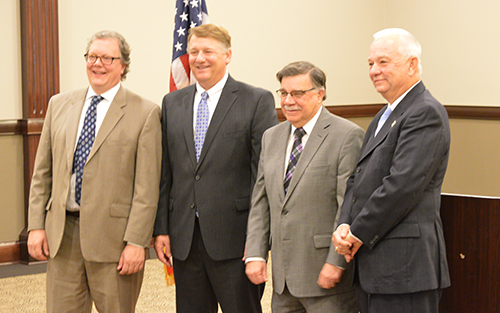Miami County continues to be strong and vibrant, county Commission President Jack Evans said during the annual State of the County program Friday, Oct. 30.
The sales tax this year is up about 6 percent over last year and the county for the sixth straight year will operate in the black and put money in reserves for future projects, Evans said.
He along with fellow commissioners John “Bud” O’Brien and Richard Cultice talked about a series of projects and efforts in the county government during the past year.
“These are exciting times to work in Miami County government with so much happening,” O’Brien said. He pointed to progress in technology, infrastructure and improvements to county owned buildings as examples.
Several advances in technology have followed the creation of a county IT department through the auditor’s office, O’Brien said. The West Central Juvenile Rehabilitation Center is the first wireless building among county buildings and will be followed by others, he said. And, the county recorder’s office has implemented electronic recording of documents, which allows for faster processing.
The county Common Pleas Court judges also are looking at courtroom technology upgrades and the treasurer’s office offers online property tax bills, O’Brien said.
When it comes to buildings, the county is in the process of finalizing HVAC and plumbing updates at the Courthouse and Safety Building. The work, O’Brien said, “has improved the environment for our employees” and is projected to save around 20 percent on utility costs.
Other recent projects include repairs and cleaning of the smokestack at the Power Plant building across from the Courthouse and the repairs to the west side of the Hobart Center for County Government following removal of the pedestrian bridge that connected the center with the Hobart manufacturing building. The bridge across Adams Street was removed as part of the building demolition.
The clock from the bridge has been installed on the west side of the Government Center building.
O’Brien also mentioned the Communication Center’s accreditation this year and the change to 12-hour shifts for employees at that operation.
Cultice said the technology changes have been important to county operations. He called the changes “major strides” and said they are key in providing services to the public.
“It is not important to be cutting edge, but it is important to be in the same century and, hopefully, in the same decade,” he said.
Cultice discussed new software in the development department to allow faster communication with employees in the field as well as with contractors handling projects.
Other pieces of good news included the reduction by $4 in the Transfer Station tipping fees for refuse and a pilot project at the county Superfund site at the landfill that will save on bills for treatment of water drawn from the site at the Troy sewage treatment plant.
The ongoing effort to deal with the prisoner situation at the county jails also was addressed by Cultice.
He said the commission has received from the sheriff’s office information needed to decide whether to open a third prisoner pod at the Incarceration Facility or continue to contract to house female prisoners in Shelby County.
“We want to make sure whatever we do, we do it right,” Cultice said.
In his other remarks, Evans pointed to ways county offices have helped the local economy. As an example he cited Treasurer Jim Stubbs’ sale of delinquent tax liens that brought in over $1.5 million to the county during the past year. Of that money, $1 million went to the area schools, he said.


